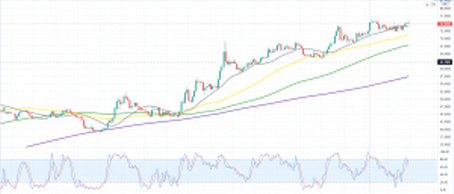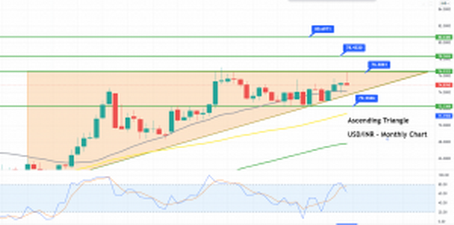USD/INR Price Forecast for 2023: What Could Trigger a Sharp Move Towards 85
Last Update: December 18th, 2023
The Indian rupee (INR) is expected to be one of the most stable currencies in the Asia-Pacific region in 2023 upwards, thanks to India’s large foreign exchange reserves and increased foreign direct investment inflows, among other factors.
This article examines the rupee’s performance this year and the factors that have influenced the predicted dollar-to-rupee path. We will also look at the most recent USD/INR rate estimate for 2022.
USD/INR – Forecast Summary
| USD/INR Forecast: 2023 Price: $82.69 – $87 Price drivers: US Politics, Post – COVID-19, Risk sentiment, Risk Currencies, Innovation |
USD/INR Forecast: 1 Year Price: $84 – $91 Price drivers: FED rhetoric, Post COVID-19, Economic Recovery, Market sentiment, USD correlation |
USD/INR Forecast: 3 Years Price: $90 – $95 Price drivers: Developing Markets, Inflation, RBI actions, FED actions, Global politics |
Price Prediction for the Indian Rupee for the Next Five Years
The USD/INR has been falling since December 2021, even though the long-term trend is bullish. Therefore, we expect this pair to fall for a little longer, until it reaches the 20 monthly SMA before resuming the bullish trend. However, not everything is simple for this pair, as several variables are influencing them right now.
The INR is undoubtedly a risk currency, with India being a developing economy that benefits when market sentiment is strong, and despite the coronavirus, the market sentiment has been primarily favorable for risk assets since May 2020. However, the USD is becoming more bullish, complicating the outlook for the INR. Although some forex brokers allow trading in INR pairs, not all of them do.
An Introduction to the Indian Rupee:
What is the Indian rupee?
The Indian rupee (INR) is the currency of India. The International Organization for Standardization’s currency code for the Indian rupee is INR, and the currency symbol is ₹. The Reserve Bank of India issues and controls it. The rupee is divided into paisas. In 1957, one rupee was equivalent to 100 paisas, i.e. the rupee was divided into 100 naye paise.
The USD/INR pair shows how many Indian rupees (the quotation currency) are required to buy one US dollar (the base currency). The rupee is represented by the symbol ₹, and it is the world’s 20th most traded currency.
Over the last two decades, the US dollar has consistently risen against the Indian rupee. In reality, we’ve seen a lot of volatility in the USD versus INR exchange rate recently. The price of both currencies is mostly decided by the FX markets, which open for business at 9 a.m.
Indian Rupee (USD/INR): Historical Data
When we convert 1 USD to INR today, the value of the Indian currency is lower than that of the USD. The value of one INR ranges from 64 to 71 USD. The US dollar is regarded as one of the world’s most valuable currencies. Its status is such that it is used to value the majority of international trade and exchange. The value of the dollar has always been higher than that of most other currencies. Higher-denomination currencies include the Kuwaiti dinar, the Bahrain dinar, the British pound and the Euro.
Currently, the INR is worth less than the USD, but that was not always the case. The scenario is substantially different today compared to the price of INR in 1947, when India gained independence. It is thought that 1 INR equaled 1 USD in the past. There are numerous theories as to why the rupee had a higher value in 1947.
Since independence, the Indian rupee has been subjected to a number of events that have lowered its value. Multiple economic crises, privatization, devaluation and World Bank loans have all played a role in deciding the value of 1 USD compared to the INR.
The US federal funds rate has remained unchanged at 0.25 percent for the last ten years, including the Great Recession of 2008. This has had an impact on the current exchange rate of INR to USD.
1991 is widely regarded as India’s year of economic transformation. Indian economists acknowledged the importance of liberalization in 1991. This change was part of India’s industrialization agenda, which began with the relaxation of limitations on imported capital goods in the 1970s.
The government faced a balance of payment difficulty, which triggered the economic crisis. It was on the verge of failing, due to constant delays. The value of the rupee fell to Rs 25 per dollar.
On May 22, 2013, the INR was 55.48 per dollar, and after fifteen days, it dropped to 57.07 per dollar. The reason for this dip was an increase in dollar demand from imports, coupled with capital withdrawals from the debt market by FIIs (Foreign institutional investors), which caused the rupee to decrease in value.
In 2016, the current Indian government took steps to phase out older banknotes and replace them with newer ones. But it ultimately contributed to the INR falling to a range between 67 and 71 in the following years.
76% of retail investor accounts lose money when trading CFDs with this provider. You should consider whether you can afford to take the high risk of losing your money.
Recent Changes in the USD/INR Price
| Period | Change ($) | Change % |
| 6 Months | +1.64 | +2.2% |
| 1 Year | -0.70 | -1.1% |
| 3 Years | +6.20 | +9.3% |
| 5 Years | +12.10 | +19.8% |
| Since 200 | +30.20 | +69.6% |
Factors affecting the Indian Rupee (USD/INR)
According to the most recent data, the Reserve Bank of India (RBI) had around $635.83 billion in foreign exchange reserves as of December 10, 2021, which was up from $578.57 billion as of December 11, 2020. The increased foreign exchange reserves reflect the RBI’s vigorous response to the COVID-19 pandemic.
India’s foreign direct investment inflows were led by the country’s direct foreign investment inflows, which amounted to $17.57 billion in the quarter ended June 2021. The inflow suggested that foreign money had been invested in the country’s markets and enterprises, and it was debt-free.
This inflow was a significant contributor to the stability of the native currency. The range of the Indian rupee, of between 72 and 75 versus the US dollar, from March 2020 to November 2021, provides evidence of this. However, this inflow fell to $13.59 billion in the quarter ending September 2021.
Factors that are predicted to influence the Indian Rupee in 2022
At its most recent policy meeting, from December 6 to 8, 2021, the RBI’s Monetary Policy Committee (MPC) maintained its key policy repurchase interest rate at 4% and the reverse repo rate at 3.35 percent. However, the Indian central bank has warned that this dovish approach may not be sustained
Although “imminent shifts in monetary policy setups by systemically important global central banks are bringing about new challenges for domestic macro-financial stability in the form of spillovers,” the bank stated that its “monetary policy stance is mainly accustomed to the evolving domestic inflation and growth dynamics.”
This suggests that the bank will retain its policy, in line with other important central bank policies, in order to keep India’s internal macroeconomic fundamentals resilient.
Inflation CPI (Consumer Price Index) Projections by the RBI
The RBI anticipates that headline inflation will peak in Q1 FY22, or the March 2022 quarter, and then fall. Taking all of these factors into account, consumer price index (CPI) inflation is expected to be 5.3 percent in fiscal FY22. CPI inflation is then predicted to fall to 5% in the second quarter of 2022 and remain at that level in the third quarter of 2022.
GDP (Gross Domestic Product) Projections by the RBI
The Indian central bank anticipates that India’s real GDP will expand by 6% in the March 2022 quarter, by 17.2% in the June 2022 quarter, and by 7.8% in the September 2022 quarter.
Thus, according to Fitch Solutions Country Risk & Industry Research, the RBI should hold its policy repurchase interest rate at 4 percent for the remainder of FY22, which ends in March 2022, and raise it by 50 basis points to 4.50 percent by the end of FY23, which ends in March 2023.
Nomura Holdings Projection on Indian Economy
Looking ahead to 2022, the Japanese financial holding company, Nomura, predicts that the Indian economy will see a robust and volatile cyclical recovery in the first half of the year, indicating that the Asian country’s 2021 experience will be repeated.
At its 2022 Asia Economic, Currencies and Equities Outlook conference, Nomura stated earlier in December that this cyclical recovery is projected, despite a low COVID-19 immunization rate, which increases the chance of virus setbacks. Nomura anticipates that India’s risk premium will climb, due to the country’s mixed growth, high inflation and larger twin deficits.
RBI’s current accommodative monetary policy
The bank anticipates that the RBI’s current accommodative monetary policy will be less dovish next year, owing to a growing consensus within the MPC that the overly accommodative policy has been in place for far too long. This discussion arose as inflationary pressures appear to be approaching the upper bounds of the RBI’s 2 percent to 6 percent target range, with core consumer price index inflation expected to remain at around 6%. Given the shrinking production gap, monetary policy cannot continue in emergency mode for long, according to business. Nomura believes that India’s real GDP will expand by 8.5 percent next year.
Ethereum (ETH) Price Prediction For 2022: The $5,000 Level is the Next Target
Bitcoin (BTC) Price Prediction For 2022: BTC/USD Targeting $100,000
USD/INR Technical Analysis – Ascending Triple to Support Uptrend in USD/INR
The USD/INR has been rising, spiking from 72.36 to 73.44 in 2021. Moving averages have performed admirably as support indicators during this period, as illustrated by the monthly chart below. When the trend was stronger, shorter-period moving averages, like the 20 SMA (gray) and the 50 SMA (yellow), offered support, whereas when the retraces down were weaker, and larger moving averages, like the 100 SMA (green) and the 200 SMA (purple), took over. The trend was quite strong during the 1990s, and the 20 SMA was the ultimate support indicator, with the 50 SMA also assisting. We experienced a strong retrace in the 2000s, which finished near the 200 SMA in 2008.

The USD/INR has reversed to trade at 74.90, after getting rejected at 76.52, which is a significant resistance level. The uptrend accelerated in the first half of the last decade, as the Greek debt crisis rocked emerging markets. We’ve witnessed numerous pullbacks since then, but they’ve all finished up at moving averages, and it appears that the price is reversing back up to the 20 monthly SMA (gray) after the pullback, as the USD has remained weak since the outbreak of the coronavirus. As a result, the bullish trend has resumed, and this pair is poised to reach new highs in the next few years.

On the monthly timeframe, we can see that after the surge in May 2021, following the coronavirus breakout, this pair became bearish in December 2021, owing to the weakness of the USD. However, moving averages are acting as support. The 20 SMA (gray) and the 50 SMA (yellow) are keeping the USD/INR price on hold, above 74 and 72.30, respectively.
A spike in demand above these support levels could extend the uptrend until 76.52, and a slice through this level would expose the pair to levels of 78.45 or 80.69 in the long run.
Alternatively, a break below the 72.33 support could extend the downtrend until the 100 SMA (green) at 68.40. On the monthly chart, we can also see an ascending triangle, which typically breaks out on the higher side; thus, the odds of a continued uptrend for the USD/INR pair remains strong. Good luck!









